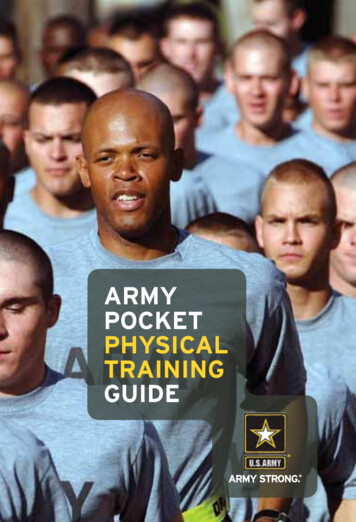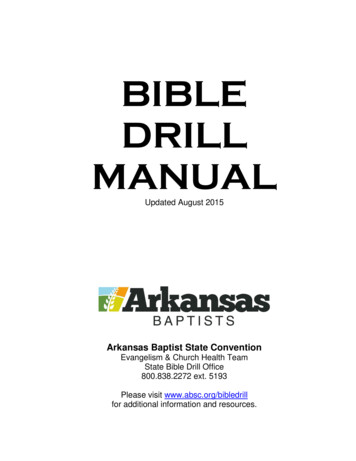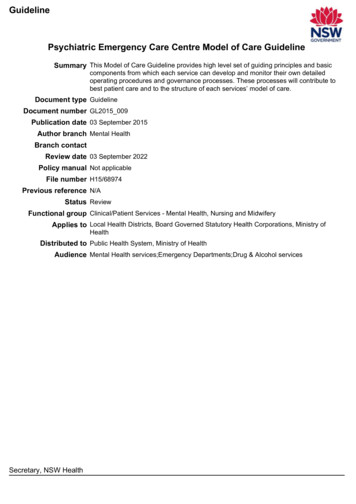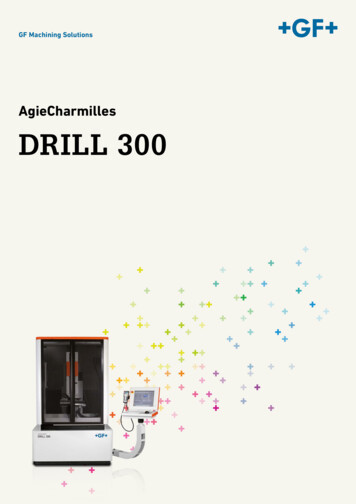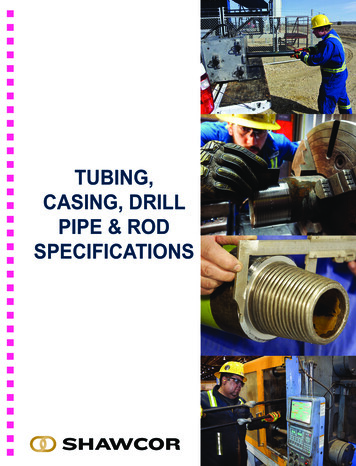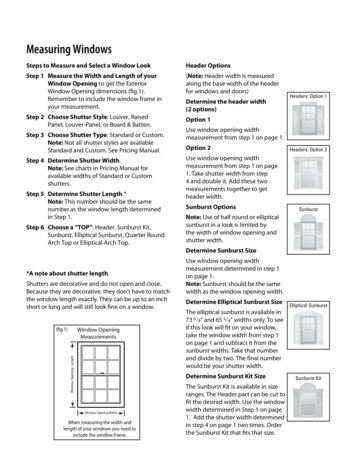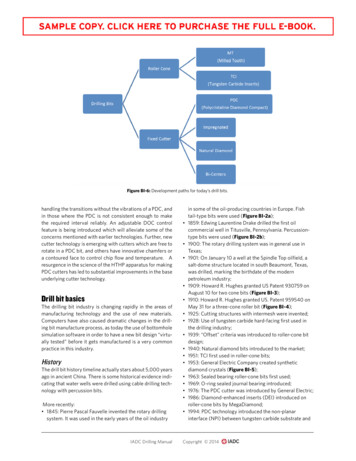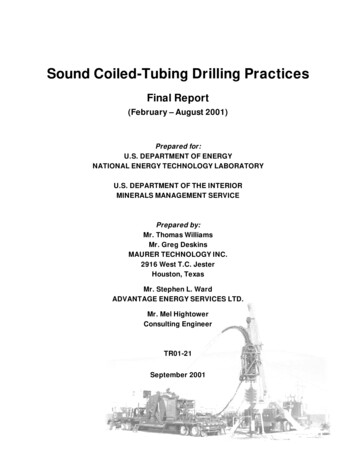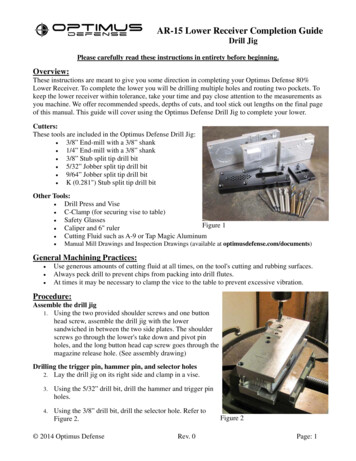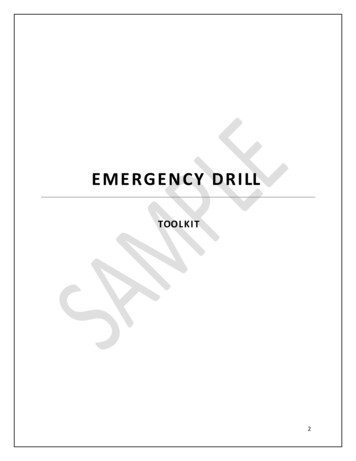
Transcription
E M E R G E N C Y D R I LLT OO L K I T2
EMERGENCY DRILL TOOLKITTABLE OF CONTENTSOrganization of the Toolkit4Purpose4Part I: Name of Clinic Conditions for Coverage409-411Emergency Preparedness of Staff412Emergency Preparedness Patient Training413Emergency equipment414Emergency plans415Evaluation of the Facility Plan416Local Emergency Management Agency4466677Part II: Preparedness versus ReadinessPreparedness vs. Readiness“R-E-A-D-Y”889PART III: Putting It All TogetherStaff & Patient TrainingMedical Director & Physician InvolvementBasic Steps for DrillsPractical Tips & Ideas for Drill ActivitiesWho-What-When-Where-Why-HowSample Scenarios10101112131518Part IV: Training & Evaluation ToolsEmergency Drill Assessment Report (sample)Patient Disaster Drill QuestionnairePatient Emergency Drill Notification (samples visual aide)323234353
ORGANIZATIONThe Name of Clinic strives to provide quality educational information and resources as part of ourresponsibility to provide assistance to Name of Clinic patients and providers.PURPOSEThe safety of the patients, staff, and visitors of Name of Clinic depends on effective plans and theability of individuals to spring into action when necessary.This Emergency Drill toolkit was developed to assist Name of Clinic in planning, conducting andevaluating Emergency Drills at Name of Clinic . Emergency drills provide opportunities to practiceemergency response and enhance the staff’s ability to implement the facility Emergency Plan when itbecomes necessary. The more familiar people are with something the better able they are to perform atask under pressure and in difficult circumstances. Emergency drills are important and beneficial inseveral ways including: Providing an opportunity for patients and staff members to rehearse the actions they wouldtake in a real emergency.Identifying weaknesses and deficits in emergency planprocesses.Identifying strengths in emergency plan processes.Meeting Conditions for Coverage requirements.Improving staff and patient readiness/preparedness levels.Familiarizing staff and patients with the facility emergencyplans.4
Part I: Name of Clinic Conditions for CoverageSome of the Name of Clinic Conditions for Coverage are provided for convenience. Name ofClinic personnel are encouraged to review the Conditions of Coverage in its entirety foradditional references to emergency planning.409 - EMERGENCY PREPAREDNESS OF STAFFThe Name of Clinic must provide appropriate training and orientation in emergency preparedness tothe staff. Staff training must be provided and evaluated at least annually and include the following:(i) Ensuring that staff can demonstrate knowledge of emergency procedures, including informingpatients ofWhat to do;Where to go, including instructions for occasions when the geographic area of Name ofClinic facility must be evacuated;Whom to contact if an emergency occurs while the patient is not in the Name of Clinic facility. This contact information must include an alternate emergency phone number for thefacility for instances when the Name of Clinic facility is unable to receive phone calls dueto an emergency situation (unless the facility has the ability to forward calls to a working phonenumber under such emergency conditions); and occurs.Informative GuidelineOrientation for all staff must include emergency preparedness training, and annual training thereafter.“Evaluated” would require some feedback to ensure that the training was effective: either a passingscore on a written test or demonstrated competency in the expected actions in an emergency situation.Staff must have sufficient knowledge of emergency procedures to educate patients/designees abouthow to handle emergencies, both in and outside of the facility. At a minimum, all of the listedcomponents must be included in the staff and patient education programs.If problems are identified regarding training patients in emergency preparedness, refer also to 412.410 EMERGENCY PREPAREDNESS OF STAFF(ii) Staff training must be provided and evaluated at least annually and include the following:Ensuring that, at a minimum, patient care staff maintain current CPR certification; andInformative GuidelineAll direct patient care staff (i.e., nurses and patient care technicians) must have current basic CPRcertification.411 EMERGENCY PREPAREDNESS OF STAFF(iii) Staff training must be provided and evaluated at least annually and include the following:Ensuring that nursing staff are properly trained in the use of emergency equipment andemergency drugs.Informative GuidelineThe minimum emergency equipment required is defined in 413. The emergency drugs to be keptonsite may be determined by the medical director and defined by facility policy.5
412 - EMERGENCY PREPAREDNESS PATIENT TRAININGThe facility must provide appropriate orientation and training to patients.Informative GuidelinePatients must have sufficient knowledge of emergency procedures to know how to handle emergencies,both in and out of the facility.Patients/designees should be instructed about the facility disaster/emergency plan. Patients/designeesshould know how to contact their facility during an emergency. Facilities should providepatients/designees with an alternate emergency phone number in case the facility phone is notanswered and/or the facility is not functioning during a disaster.For emergencies occurring in the Name of Clinic facility, patients should be able to verbalize how theywould evacuate the facility, or if unable, how they will be evacuated. The facility should have a systemin place to identify patients who will need assistance in disconnection and evacuation during anemergency.Medical records should include evidence of education in emergency evacuation and emergencypreparedness, to include some measure of patient understanding, such as return teaching ordemonstration.413 - EMERGENCY EQUIPMENTEmergency equipment, including, but not limited to, oxygen, airways, suction, defibrillator or automatedexternal defibrillator, artificial resuscitator, and emergency drugs, must be on the premises at all timesand immediately available.Informative GuidelineThe emergency equipment, as listed, must be clean, accessible, and ready to use at all times.“On the premises” and “immediately available” may include the use of an emergency response team.The response time of personnel and equipment should be demonstrated as being less than 4 minutes.414 - EMERGENCY PLANSThe facility must have a plan to obtain emergency medical system assistance when needed;Informative GuidelineAll members of the Name of Clinic staff must be able to demonstrate knowledge of how to obtainemergency medical assistance, e.g., 911 systems or equivalent for the locality.6
415 – EVALUATION OF THE FACILITY PLANThe facility must evaluate at least annually the effectiveness of the emergency and disaster plans andupdate them as necessary.Informative GuidelineThis annual evaluation process should include review of any medical or non-medical emergencies thathave occurred during the year to determine opportunities for improvement, as well as re-evaluation ofthe plans/procedures for current appropriateness and feasibility.The facility must conduct drills or mock emergencies at least annually in order to determine the staff'sskill level/educational needs and effectiveness of their plan.416 – CONTACT YOUR LOCAL EMERGENCY MANAGEMENT AGENCYThe facility must contact their local disaster management agency at least annually to ensure that suchagency is aware of Name of Clinic facility needs in the event of an emergency.Informative GuidelineThe facility must contact and develop a communicative relationship with the local disaster managementagency. This relationship will help expedite restoration of interrupted services due to an emergency ordisaster. There should be some documented evidence of this contact. In order to ensure services will beavailable in the event of an emergency or disaster, facilities should collaborate with their suppliers, utilityservice providers, and their State agencies for survey and for emergency preparedness as well as withother clinics.7
Part II: Preparedness versus ReadinessIt is possible to have a level of preparedness and still not be ready. For example, someone who has afirst- aid kit may be prepared, but if they lack the self-confidence to clean and bandage a wound, theyare not ready to respond.Preparedness: Involves two parts: Physical & Mental Preparedness1. Physical preparedness. “Physical” in this sense is not the physical body but rather tangible or real,encompassing activities such as:Increasing securityFacility fortificationStockpiling of supplies and equipment2. Mental preparedness is created through:Planning activitiesTrainingDrills/exercisesEvaluation to identify deficienciesGoal: Building self-confidence, efficiency, and effectiveness in performing tasks. Physical and mentalpreparedness practiced regularly lead to READINESS.Readiness: Being ready to spring in to action should an emergency situation occur involvesseveral things:1. Self-confidence and knowing that you can do the required tasks correctly.2. Confidence in others, including coworkers, team members, and patients. Being able to trust them toperform or react correctly.3. Confidence in the Name of Clinic and its staff, and being confident that they are ready and able toact.Goal: Individual readiness and group readinessTo achieve the goals, the following are needed: Knowledge that we have prepared. Belief that we are ready, exemplified by a “can do” attitude and positive state of mind.8
R-E-A-D-YUse the acronym “R-E-A-D-Y” to coordinate your drills.R – RehearseIt is through rehearsal and practice that actions become second nature.E –ExerciseHold frequent drills and exercise activities to fine-tune the emergency and disaster skills of the patientsand staff members.A –AssessAssess how well your emergency plans address the situation. Are there things you forgot to plan for?Does the plan need to be updated, edited, or enhanced in some way? Assessment is part of thecontinuous quality improvement (CQI) and Quality Assurance Performance Improvement (QAPI)processes.D – DevelopDevelop your plans realistically and facility-specifically. Conduct a variety of drill scenarios often(recommended quarterly) to allow individuals to mentally rehearse what their actions would be in caseof a real situation. Add and perhaps delete actions, supplies, and practices as appropriate to meet theneeds. Document your education efforts and also involve the Medical Director in the training. Be sure toeducate patients and staff members -including the physicians and non-medical staff members.Y– YearlyYearly (at least) the facility plans should be re-assessed. More frequent assessments are alwaysencouraged.9
PART III: Putting It All TogetherStaff and Patient TrainingAll facility personnel and patients should be trained in emergency response.The facility’s emergency plan should include roles and responsibilities for all staff members. All staffshould have knowledge of:The physical layout of the facility;The location of the nearest exit, alternate exit and the direct route to each;The location and how to use fire extinguishers;The patient evacuation priorities of the facility;How to evacuate patients;Emergency telephone numbers and procedures;How to assume control, maintain calm and prevent panic;How to instruct co-workers in their emergency roles;The emergency evacuation area location; andThe utility and water shut-offs.All patients should be trained in emergency response.emergency planning activities.Patients want and need to be involved inAll patients should have knowledge of:Facility exit locationsThe location of the nearest exit, alternate exit and the direct route to eachEmergency telephone numbers and proceduresThe emergency evacuation area locationCommunication must be provided assuring everyone that this is “only a drill”, however. If the drill ishandled in an educational, calm, and informative manner patients will not be overly concerned orfrightened by it.10
Medical Directors and Physician InvolvementPhysicians play a vital part if/when a real emergency occurs and they need opportunities to practicetasks to be confident in their actions and roles just like anyone else at the facility.Here are some ideas for physician participation:1. Schedule: Let all of the physicians know in advance when a scheduled emergency drill is beingheld (in person if possible). Try to hold the drill around their schedules if possible to increaseparticipation.2. Meet: Hold a management meeting with the physicians to discuss:Ordering the evacuation of the facility (circumstances, authority, communication, etc.)Emergency communications (paging MDs, call trees, special codes)Standing orders for emergenciesProcedures that are not performed routinely3. Review: SBAR Communication for emergencies. Consider using this strategy as a fast andeffective means of getting information shared that your team.S Situation: What is going on? Concisely state what the issue is.B Background: Give quick background information pertinent to situation.A Assessment: What do you think the emergency is?R Recommendation: What action/recommendation is needed to correct problem?4. Practice: The following hands-on tasks should be reviewed with the physicians routinely. Theyshould be allowed to practice privately away from the Name of Clinic staff members andpatients.5. Policies: The management team should review emergency policies routinely to identify processissues that need to be updated.11
Basic Steps for DrillsAn annual review of the Name of Clinic facility emergency plan is required. Regular disaster drills areencouraged. Be sure every shift has the opportunity to participate. Not all drills should be announced - a surprise drill will help reinforce learning. Regular practice can help to instill an awareness,calmness and preparedness in the minds of all. Emergency drills require planning and organization toensure the most benefit.The three essential requirements for conducting a successful drill include:1. Pre-drill education for all staff and patients. This should be an on-going effort.2. A step-by-step plan for executing the drill.3. Post-drill evaluation and recommendations.The purpose of a drill is to practice skills necessary to ensure the safety of all. Both patients and staffshould be included in the drill exercise. The drill in the clinic setting should focus on specific tasks thatare not routinely performed but are critical to the safety and evacuation of patients and staff. Whendesigning a drill, pick a disaster that is applicable for your area. Vary the drill by using the “worst-case”and “ideal” scenarios.Worst-case scenario is the most unpleasant or serious thing that could happen in a situation, wherestaff would not have time to think it through, but only react. This will require staff to respond quickly,assist and/or verbally instruct patients, and evacuate themselves and patients.Ideal scenario allows staff to have time to ensure patients are safely informed and evacuated.EvaluationThe person-in-charge completes a verbal and written evaluation (drill report) following eachdrill. Group discussions with employees will also be held. Items to review include, but are not limited to: not hearing the alarm, fire equipmentblocked or unusable, exits and/or hallways blocked, operations hindered, duties notunderstood or carried out. Record staff attendance/participation with a sign in sheet. File drill report and attendance record in quality assurance/improvement report logand staff training log. Record patient education and participation in the drill in their medical record. A deadline for drill make up and/or evaluation of skill performance for absentee staffshould be provided. The facility should conduct continuous quality improvement (CQI) on drills, including rootcause analysis for problem areas.12
Practical Tips & Ideas for Drill ActivitiesFireSudden power outageExtended power outageSudden water lossContaminated water supply/chloramines break throughTornadoWinter Weather eventsSudden floodingEarthquakeViolent patient, family or staff memberCommunity Emergency PreparednessThe following ideas can be used at any clinic regardless of its size or staffing patterns to address anypossible emergency/disaster scenario.1.Inform the patients ahead of time that the clinic will be conducting an emergency drill. Givingthem notice will help them remain calm and feel ready to practice.2.If there are several of your clinics nearby, host a Disaster Planning Summit during the eveningand train everyone together.3. Rotate the duty of planning the drills (gets more people involved and keeps it from becomingthe same-old- thing).4. Involve your Medical Director and physicians in emergency drills and training sessions.5.Mark quarterly drills on the calendar than have the drill(s). Conduct drills on all patient shiftsidentify issues that may be time specific.6. Simulate how the clinic would go about placing a PSA on their local TV or radio.7. Determine who the clinic would contact to provide transportation for a large number ofpatients.8.Pick a date and time and see if the facility emergency supplies would accommodate the currentcensus of patients.9.Ask members of the local fire department/rescue to come to the clinic to “walk through”what would need to happen in order to evacuate the patients.10. On a Sunday or in the evening, hav e staff and volunteers pretend to be patients and actuallysimulate an evacuation and/or triage of multiple wounded individuals.11. Plan with the local hospital ER ahead of time to simulate the arrival of multiple Name of13
Clinic patients.12. Brainstorm with your team about how a community wide disaster might play out and the stepsnecessary to ensure that your patients had access beyond their local area. What supplies wouldyou need? Where would staff and patients go? How would you notify people? What abouttransportation, etc.13. Mix the scenarios in with city or local emergency management drills that are already being donein the area. The more the community learns about the needs of Name of Clinic , the morevarious agencies can assist during a real emergency.14. Participate in state and/or national drills.14
Who?Who-What-When-Where-Why-HowUsing this model helps to clarify the actions, roles, andresponsibilities of individuals during a disaster drill. Itprovides a framework to organize a comprehensivedrill experience for the participants. Let’s look at eachelement individually.Who?How?What?Why?When?Where?Who are the people involved? Is it staff members,patients, both? Are others also involved behind the scenes? What about the Medical Director? Who isultimately responsible? Who leads and directs the actions of others? Who else may be available to helpand lend a hand? Assign staff accordingly.What?What needs to happen to keep everyone (patients, staff, and visitors) safe and out of harm’s way? Whatcan be done to limit damage to the Name of Clinic property? What role does each staffmember assume? What can patients do to help themselves? What specific action steps need to betaken in each scenario?When?Describe the timeline for action steps that have been identified.Where?Where is the evacuation meeting point for patients and staff members? Where are the patients to gofor back-up treatments? Where are staff to report?Why?Knowing why particular actions are taken helps patients and staff to better understand the wholeemergency planning process. What is the background information? If possible, share the reasoningbehind facility actions, plans, policies, etc.How?How are patients to get to the back-up center? Is transportation going to be provided? How will thepatients and staff members know if the center is providing services or if they need to go elsewhere?How will communication be taking place – call trees, public service announcements, etc. How canprotection be provided?SAMPLE SCENERIOSThe following tables use the WHO-WHAT-WHEN-WHERE-WHY-HOW model along with the bestcase/worst case designation to describe possible emergency drill sc enarios and actions. Followyour facility’s emergency plan, policies, and procedures. The following are suggestions for drills.15
FIREFires can be small or large;contained or widespread.Smoke inhalation is a majorconcern as well aspotential burns toindividuals. Propertydamage can occur.Who: Prior to afire all staffshould be taughthow to use thefire extinguisherand know theevacuationroutes.What: Call 911Use fireextinguisherPossibleevacuationAssign someoneto simulate thecall to 911 andbe sure it wasdone.Best CaseWorst CaseDrill IdeaWhen: Upondiscovery of thefire.Where: A fire couldtake placeanywhere in oraround the facility.Why: Clinics use a lot ofelectrical equipment thatcould catch fire; somepatients, visitors, andstaff members smoke;nearby homes orbusinesses may catch fireand spread to the clinic.How: Hold fireextinguisher class (thefire department will dothis for you sometimes)Have fire safety weekat the clinic. Pass outeducational materials.Swift and decisiveactions are needed.Able to put fire out without fire department intervention, no or limited damage, no or minor injuries, evacuation not necessary.Evacuation, fire department, injuries, death, property damage or loss.Place a sign (8.5 x11 sheet of paper with a clip art design of a fire or draw it with markers) on an object such as a copymachine, waste basket, etc.When someone discovers the fake “fire” walk through the appropriate actions that should be taken and by whom.Document the participants and scenario on a Disaster Drill sheet.Assess your response to the “fire” and see what went well and what could have been done better, faster, etc. What lessonswere learned?Review the drill19
WinterWeatherEventsWho: Patientsand staffWhat: Difficultygetting to orinability to cometo the clinicWhen: UsuallyNovemberthrough MarchWhere:Rural or urbanWhy: Snow, ice,and extreme coldare common in ourregion.How: Train patients,new staff members andcurrent staff on how torespond to and plan forwinter weather events.Best CaseWorst CaseDrill IdeaMost patients and staff members are able to get to the clinic. Perhaps the clinic will open a little later.Patients and staff members are unable to get to the clinic because of ice, heavy snow, etc.On a weekend or evening, plan with your staff members to “try out” your emergency call tree. Check to see that everyonewas called. Document your test. If the call tree did not work, revise it now.Discuss with the team how you would notify patients that could not make it in;20
EarthquakeWho: Everyonecan be affectedby earthquake.What: Drop,Cover and HoldOn. Drop under asturdy desk or table,hold onto the deskor table with onehand, and protectthe back of the headwith the otherhand.Best CaseWorst CaseDrill IdeaWhen: When youfeel the groundmoving,Where:Right where youare.Why: Items can falloff of shelves orbookcases. Heavyitems can fall overor roll.How: Protect yourhead. Hold on.Swift and decisiveactions are needed.Small tremor. Little or no damage. Minor or no injuries.Large tremor. Structural damage to the clinic. Injuries or deaths reported.Look around your area and identify furniture or objects that could pose safety hazards if they fell on staff, patients, orvisitors.Take steps to better secure items in your areas for the possibility of an earthquake.Put earthquake information on the clinic’s bulletin boards for staff, patients, and visitors toreview. Distribute a one-page educational information sheet to everyone at your unit.Ask the management team within your clinic to simulate an earthquake (after hours). Use your experience to evaluateand update your policies and procedures. Be sure to document this earthquake drill!Review earthquake safety plans with your patients.Have a staff meeting to discuss earthquakes and to plan facility strategies.21
SuddenFloodingWho: Thissituation canaffect bothpatients and staffmembers.What: The buildingand/or contentscan be damaged byflooding.Staff and patientsmay not be ableto arrive at orleave the clinic.Best CaseWorst CaseDrill IdeaWhen: Floodingusually happensin the spring andsummer, but canhappen in the fallor winter if thereis a sudden snowmelting.Where: Suddenflooding can occurin Rural or urbanareas.Why: The groundcan becomesaturated quicklywith heavy orprolonged rains orsnow melting.How: Train patients,new staff members andcurrent staff on how torespond to and plan forflooding events.Swift and decisiveactions are needed.The drains behind the machines have become clogged causing a small and contained overflow in the clinic. (Be particularly carefuland mindful about the potential of shock injuries of staff and patients due to electrical equipment and water.)The city or area is flooded including the clinic. Equipment is damaged or lost and the facility has suffered structuraldamage.Inspect the drains behind the machines to assess water flowScenario: The river, creek, or lake located nearest the clinic has exceeded its banks due to heavy rainfall. Certain mainroads are covered with water and impassable.22
TornadoBest CaseWorst CaseDrill IdeaWho: Staff,patients, andvisitors could beat risk of injury ordeath.What:When: "tornadoseason" generally isin the spring.Tornadoes are moreprevalent from Aprilthrough July, withMay and June beingthe peak months.But likethunderstorms,tornadoes can formany time of theyear.Where: A tornadoWhy: Tornadocan occur in MS. damage can beRural or urban.severe. The entirebuilding orcommunity could beaffected. Livescould be lost.How: Monitor theweather conditions viaa weather radio, radio,TV, etc.Take shelter ifnecessary. (i.e. Go to apre-designated shelterarea such as a safeSwift and decisiveactions are needed. room or the lowestbuilding level. Go to thecenter of an interiorroom on the lowestlevel away fromcorners, windows,doors, and outsidewalls. Put as many wallsas possible betweenyou and the outside.Get under a sturdytable and use your armsto protect your headand neck. Do not openwindows.The weather conditions in the area are such that a tornado is possible. The clinic is alert to the weather forecast and is monitoringthe situation.A tornado is impacting the clinic. Patients, staff, and visitors must be moved to safety. The facility has sustained damageand is unable to perform treatments.Designate a safe area at the clinic in which to take shelter. Review thedifferences between tornado watches and tornado warnings.Use a tornado preparation Power Point presentation for the employees and doctors at a staff meeting.23
ViolenceWho: Staff,patients, andvisitors could beat risk of injury ordeath.What: Violencecould range fromunpleasant verbalexchanges all theway to assaultwith a deadlyweapon.When: A violentincident couldoccur at anytime.Where: A violentincident could occuranywhere on thefacility property.Best CaseWorst CaseDrill IdeaThe upset individual leaves the clinic without an incident.The patients, staff, and visitors are in harm’s way. People could be injured or killed.Why: Any numberof reasons couldcause a person tohave a violentoutburst.Sometimes mentalillness and/orsubstance abuseplay a role as well.How: Be aware ofdisgruntled employees,visitors, or patients.Make every effort toprevent small problemsfrom becoming bigones.Evaluate the securityneeds of the clinic.(Lighting, locks,restricted entry, etc.)Brainstorm with your team about how the clinic would react to a violent occurrence in various locations at the facility such as the patienttreatment area, office, break area, etc.Provide general workplace security training and instruction including, but not limited to, the following:1. Ways to defuse hostile or threatening situations. Conflict resolution.2. Dealing with angry, hostile or threatening individuals3. Awareness of situational indicators that lead to violent acts4. Evaluate the availability of phones in the clinic to call 911.5. Measures to summon others for assistance.6. Worker routes of escape.7. Proper work practices for specific workplace activities, such as special events, working late/weekends8. Self-protectionConduct and evaluate patient satisfaction monitoring activities.Track and trend any and all workplace violence incidents.Hold a staff meeting to explore the security needs of the clinic.Involve your team in discussing possible violent behavior situations and formulating an action plan.Review the clinic’s internal grievance policy. The internal grievance process needs to include a procedure for submission of grievances;timeframes for reviewing the grievance, and a description of how the patient will be informed of the steps taken to resolve the issue.The facility also needs to establish a procedure for informing patients about seeking external help to resolve gr ievances that cannot beresolved internally, or if patients are not comfortable using the internal process.24
CommunityEmergencyPreparednessActivitiesBest CaseWorst CaseDrill IdeaWho: Every clinic What: Be asis encouraged to involved asbe involved with possible.their localemergencyplanning activities.When: As oftenas possible.Where: Volunteer tohost an activity ifpossible. Go toother communityevents.Why: InvolvementHow: Contact yourprovides the cliniclocal emergencywith neededmanagement agencyinformation and the and ask aboutemergencyopportunities to bemanagementinvolved withagency with realistic community exercises.information aboutthe needs of theclinic’s community.The local community will understand the needs of the clinic and be ready and able to respond to them should an emergencyor disaster occur.The community will at least have some understanding of the needs of the clinic’s population.Contact your local emergency management agency and offer to host a community drill.Invi
first- aid kit may be prepared, but if they lack the self-confidence to clean and bandage a wound, they are not ready to respond. Preparedness: Involves two parts: Physical & Mental Preparedness 1. Physical preparedness. “Physical” in this sense is not the physical body but
